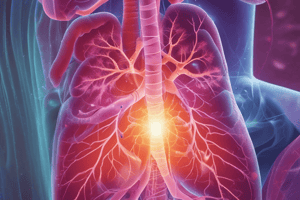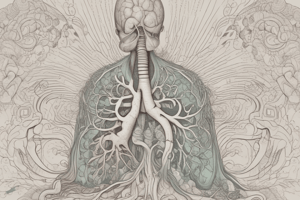Podcast
Questions and Answers
What is the correct way to hold an inhaler?
What is the correct way to hold an inhaler?
- Hold with mouthpiece at an angle
- Hold with mouthpiece up
- Hold with mouthpiece down (correct)
- Hold with mouthpiece sideways
What is the primary use of Ipratropium?
What is the primary use of Ipratropium?
- To reduce inflammation
- To treat allergic reactions
- To relieve respiratory symptoms
- To open up airways (correct)
What is a common side effect of Terbutaline?
What is a common side effect of Terbutaline?
- Hypoglycemia
- Tachycardia (correct)
- Bradycardia
- Hypotension
What is the purpose of a spacer in inhaler use?
What is the purpose of a spacer in inhaler use?
What type of medication is Montelukast?
What type of medication is Montelukast?
What is the purpose of Guaifenesin?
What is the purpose of Guaifenesin?
What is a common consideration for patients taking Bronchodilators?
What is a common consideration for patients taking Bronchodilators?
What is the purpose of placing the end of a chest tube in a bottle of sterile water?
What is the purpose of placing the end of a chest tube in a bottle of sterile water?
What is the main cause of crackles in adventitious breath sounds?
What is the main cause of crackles in adventitious breath sounds?
What is the purpose of a non-rebreather mask in respiratory support?
What is the purpose of a non-rebreather mask in respiratory support?
What is the primary indication for using a Venturi mask in respiratory support?
What is the primary indication for using a Venturi mask in respiratory support?
What is the primary purpose of a chest X-ray in endotracheal tube placement?
What is the primary purpose of a chest X-ray in endotracheal tube placement?
What is the primary concern when suctioning a tracheostomy tube?
What is the primary concern when suctioning a tracheostomy tube?
What is the purpose of the water seal chamber in a drainage system?
What is the purpose of the water seal chamber in a drainage system?
What should the nurse do if the chest tube comes out?
What should the nurse do if the chest tube comes out?
What is the primary concern when managing a drainage collection chamber?
What is the primary concern when managing a drainage collection chamber?
Flashcards are hidden until you start studying
Study Notes
Adventitious Breath Sounds
- Crackles: indicate fluid, mucous, or pus in the lungs
- Rhonchi (snoring): indicate secretions in large airways
- Wheezes: indicate airway constriction
- Diminished: indicate shallowed or restricted breathing
- Stridor (high-pitched): indicate upper airway obstruction
Respiratory Support
- Low Flow:
- Nasal Cannula
- Simple Face Mask (35-45%)
- Non-rebreather (100%): ensure reservoir bag is filled up
- High Flow:
- Venturi Mask (4-6L, up to 40L)
- High flow nasal cannula
- CPAP:
- For Obstructive Sleep Apnea (OSA)
- BiPAP:
- Allows for lower pressure during exhalation (for complex breathing pressures)
- Invasive Ventilation:
- Endotracheal tube
- Tracheostomy
- Mechanical ventilator
Ventilator Alarms
- High: obstruction
- Low: leak
- For a alarm: assess client first, assess machine, call resp support
- If patient is distressed, give sedation
Endotracheal Tubes
- Verify placement with a chest X-ray (gold standard)
- Assess for equal breath sounds
- End-tidal capnography (CO2 detector): ensure paper changes to a yellow color
Tracheostomies
- Long-term trach tube
- Stoma made into the neck, breathing through the neck
- Tracheostomy Care:
- 1-2 fingers fit under straps
- Infection prevention (inpatient only, daily care is a sterile procedure)
- Fowler/Semi position
- Use gauze soaked with NS, then dry skin, apply new sterile dressing, change trach ties
- Suctioning: only do it to the pre-measured depth, no longer than 10 seconds, and pre-hyperoxygenate
Chest Tubes
- Drainage System Chambers:
- Suction Control Chamber: no tidaling, gentle bubbling, replace fluid with NS
- Water Seal Chamber: tidaling, intermittent bubbling, stop tidaling indicates obstruction or lung re-expansion
- Drainage Collection Chamber: no tidaling/bubbling, pink drainage
- Nursing Considerations:
- Keep below chest level
- No dependent loops
- Drainage should be no more than 100 ml/hr
- What to do if the chest tube comes out: cover the site with a sterile dressing, tape on 3 sides, call the PCP, and stay with the client
Bronchodilators/Albuterol
- Bronchodilators:
- Albuterol
- Terbutaline
- Ipratropium (anticholinergic, COPD/asthma): smooth muscle relaxation
- Considerations:
- Cautious with patients who have heart disease, diabetes, glaucoma, or seizures
- Causes tachycardia, only discontinue if it causes severe problems
Terbutaline
- Rescue/relief and maintenance drug for wheezing, SOB, and coughing caused by asthma
- Nursing Considerations:
- Side effects: shakiness, jitteriness, dizziness, drowsiness, sleep disturbances, weakness, headache, vomiting, tachycardia, hypertension, hyperglycemia, CNS overstimulation
- Assess HR, BP, EKG, BG
- Given orally, SC, or by inhaler, lasts 4-6 hours
- More side effects with oral administration
- Teach proper inhaler use
Inhalers and Spacers
- Inhaler Education:
- Hold with mouthpiece down, do not hold upside down
- Seal lips tightly around mouthpiece
- Press down on inhaler one time, one breath in = one puff of medication
- Continue inhaling while medication is dispensed, breathe slowly and as deeply as possible
- Shake prior to use
- Spacer Education:
- Connects to the mouthpiece of the inhaler
- Timing of the breath is less important
- Wastes less medication
- Mostly used in pediatrics
Miscellaneous Respiratory Medications
- Montelukast: for allergies/asthma, long-term control (not rescue medication)
- Guaifenesin: expectorant, to get patient coughing to bring out secretions
- Acetylcysteine: mucolytic, breaks up mucus
- Pseudoephedrine, phenylephrine: reduces edema/decongestant
- Antitussives: dextromethorphan, codeine
Steroids (Respiratory)
- SONE (Steroids in Obstructive Narrowing of the airways)
- Betamethasone
- Dexamethasone
Studying That Suits You
Use AI to generate personalized quizzes and flashcards to suit your learning preferences.




